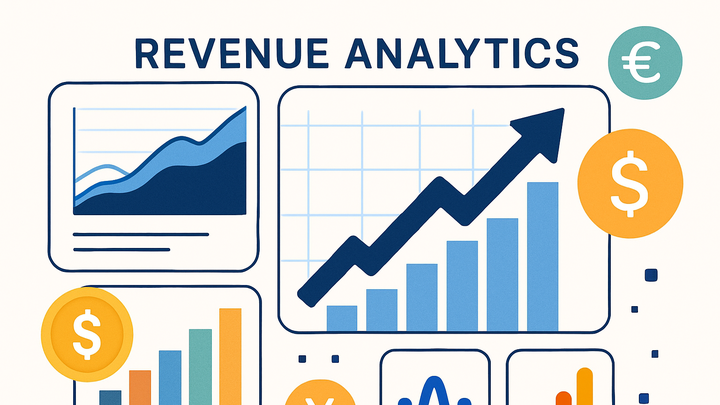Published on 2025-06-26T05:22:11Z
What is Revenue in Analytics?
Revenue in analytics refers to the total monetary value generated by user actions, such as transactions, subscriptions, or in-app purchases. Tracking revenue helps businesses understand sales performance, customer behavior, and marketing ROI. Analytics platforms like PlainSignal and Google Analytics 4 enable teams to capture revenue events, attribute them to channels, and visualize trends over time. Accurate revenue data is essential for budgeting, forecasting, and optimizing product or pricing strategies. By combining revenue metrics with user segmentation and attribution models, companies can pinpoint growth opportunities and make data-driven decisions. Proper implementation and regular validation of revenue tracking ensure data integrity and trust across teams.
Revenue
Revenue is the total income generated by users, tracked via analytics tools to gauge business health, optimize marketing, and inform strategy.
Why Revenue Matters in Analytics
Revenue is a critical KPI that indicates the financial performance of your product or service. Monitoring revenue trends helps teams assess the effectiveness of marketing efforts, product launches, and pricing strategies. Without accurate revenue metrics, businesses lack the insights needed to allocate resources wisely or justify investment decisions.
-
Measure business health
Revenue directly reflects sales success and overall business viability.
-
Optimize marketing spend
By attributing revenue to marketing channels, you can invest more in high-ROI campaigns.
-
Inform product strategy
Revenue patterns reveal customer preferences, guiding feature development and pricing.
How to Track Revenue
Tracking revenue involves capturing purchase events on your site or app and sending them to analytics platforms. Below are common methods using PlainSignal and Google Analytics 4.
-
PlainSignal integration
PlainSignal offers a cookie-free approach to analytics. To track revenue, include the PlainSignal snippet and fire a purchase event when a transaction completes:
<link rel="preconnect" href="//eu.plainsignal.com/" crossorigin /> <script defer data-do="yourwebsitedomain.com" data-id="0GQV1xmtzQQ" data-api="//eu.plainsignal.com" src="//cdn.plainsignal.com/plainsignal-min.js"></script>Then use the JavaScript API to report revenue values:
ps('event', 'purchase', { value: 42.99, currency: 'USD' });-
Cookie-free tracking
PlainSignal respects user privacy by avoiding cookies, reducing compliance overhead.
-
Simple api
A minimal JavaScript API makes it easy to send purchase events with value and currency.
-
-
Google analytics 4 integration
GA4 captures revenue through the
purchaseevent. Ensure it includesvalue,currency, andtransaction_id. Example:gtag('event', 'purchase', { currency: 'USD', value: 23.07, transaction_id: 'T12345' });-
Enhanced e-commerce
Use GA4’s enhanced ecommerce schema to capture product details, quantities, and coupon codes.
-
Measurement id
Verify your Measurement ID in the
gtag.jssnippet so events map to the correct property.
-
-
Validating revenue data
Regularly reconcile analytics data with backend systems to ensure accuracy, looking for discrepancies in totals, missing transactions, or timing issues.
-
Backend comparison
Compare analytics-reported revenue against your database or CRM records.
-
Time zone settings
Ensure time zone alignment between your site, analytics tool, and backend systems to avoid mismatches.
-
Best Practices for Revenue Analytics
To maintain reliable revenue insights, adopt consistent processes, test strategies, and use segmentation to uncover deeper trends.
-
Implement consistent attribution
Choose an attribution model (e.g., last-click, first-click) and apply it uniformly to evaluate channel performance.
-
Use a/b testing for pricing
Test different price points or discount strategies and measure revenue lift to optimize conversions.
-
Segment revenue by cohorts
Analyze revenue by user segments or cohorts (new vs. returning) to understand lifetime value and retention.
Common Challenges in Revenue Tracking
Accurately capturing revenue can be hindered by technical limitations, privacy controls, and data consistency issues.
-
Ad blockers and privacy laws
Users may block scripts or decline consent, leading to underreported revenue.
-
Data sampling limits
Some analytics tools sample data above thresholds, causing slight inaccuracies in revenue totals.
-
Delayed transactions
Refunds or delayed payment captures can distort revenue figures if not handled in real-time.
